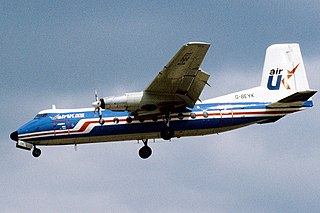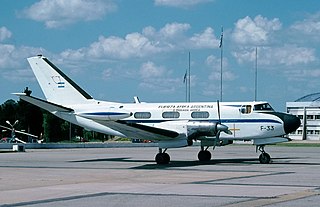
The Handley Page HP.137 Jetstream is a small twin-turboprop airliner, with a pressurised fuselage. The aircraft was designed to meet the requirements of the United States commuter and regional airline market. The design was later improved and built by British Aerospace as the BAe Jetstream 31 and BAe Jetstream 32, featuring different turboprop engines.

The Pilatus PC-6 Porter is a single-engined STOL utility aircraft designed by Pilatus Aircraft of Switzerland. First flown in 1959, the PC-6 was produced at Pilatus Flugzeugwerke in Stans, Switzerland. It has been built in both piston engine- and turboprop-powered versions, and was produced under licence for a time by Fairchild Hiller in the United States. After 604 deliveries in 63 years, Pilatus ended production in 2022.

The FMA IA 58 Pucará is an Argentine ground-attack and counter-insurgency (COIN) aircraft manufactured by the Fábrica Militar de Aviones. It is a low-wing twin-turboprop all-metal monoplane with retractable landing gear, capable of operating from unprepared strips when operationally required. The type saw action during the Falklands War and the Sri Lankan Civil War.

The Short 330 is a small turboprop transport aircraft produced by Short Brothers. It seats up to 30 people and was relatively inexpensive and had low maintenance costs at the time of its introduction in 1976. The 330 was based on the SC.7 Skyvan. The C-23 Sherpa was a military version of the 330. Production of the aircraft ended in 1992, after 141 were produced. The Short 360 was a development of the Short 330.

The Handley Page Dart Herald is a 1950s British turboprop passenger aircraft.

The Aérospatiale N 262 is a French twin-turboprop high-wing airliner built first by Nord Aviation. The aircraft was also known as the Nord 262.

The Israeli Aircraft Industries Arava is a light STOL utility transport aircraft developed and produced by Israeli aerospace company Israel Aerospace Industries (IAI). It is IAI's first indigenously developed aircraft design to enter production.

The Turbomeca Astazou is a highly successful series of turboprop and turboshaft engines, first run in 1957. The original version weighed 110 kg (243 lb) and developed 240 kW (320 shp) at 40,000 rpm. It was admitted for aviation service on May 29, 1961, after a 150-hour test run. The main developing engineer was G. Sporer. It was named after two summits of the Pyrenees.

The I.A. 50 Guaraní II is an Argentine utility aircraft designed at the DINFIA in the early 1960s.

The Breguet 941 was a French four-engine turboprop short takeoff and landing (STOL) transport aircraft developed by Breguet in the 1960s. Although widely promoted, both by Breguet in France and by McDonnell Aircraft and McDonnell Douglas in the United States, it was not built in large numbers; only one prototype and four production aircraft were built.
The Dassault M.D.320 Hirondelle was a French 14-seat utility transport aircraft of the 1960s, designed and built by Dassault Aviation, in prototype form only.

The Dassault MD.415 Communauté was a 1950s French twin-engined light turboprop transport monoplane built by Dassault Aviation. Only one prototype was built and flown.

The Nord 1100 Noralpha was a French-built and re-engined Messerschmitt Bf 108 produced by Nord Aviation.
The FMA IA.62 was a military trainer aircraft under development in Argentina in the late 1970s.

The Potez 840 was a 1960s French four-engined 18-passenger executive monoplane, the last aircraft to use the Potez name.

The Continental CAE T51 was a small turboshaft engine produced by Continental Aviation and Engineering (CAE) under license from Turbomeca. A development of the Artouste, it was followed by three additional turboshaft engines, the T72, the T65, and the T67. However, none of these engines, including the T51, entered full production. CAE abandoned turboshaft development in 1967 after the XT67 lost to the Pratt & Whitney Canada PT6T (T400) to power the Bell UH-1N Twin Huey.
The Turbomeca Astafan is a single-spool, variable-pitch turbofan engine developed from the Turbomeca Astazou. Despite successful flight-testing, an efficient, quiet and clean design and some commercial interest, the Astafan never entered series production. The engines were only flown on the Fouga 90 prototype and Turbomeca's two test aircraft.

The British Aerospace Jetstream is a small twin turboprop airliner, with a pressurised fuselage, developed as the Jetstream 31 from the earlier Handley Page Jetstream. A larger version of the Jetstream was also manufactured, the British Aerospace Jetstream 41.

The Nord 260, built in prototype form as the Max Holste MH.260 Super Broussard,, was a turboprop-powered, uprated version of the piston-engined Max Holste MH.250 Super Broussard, that was further developed into the Aérospatiale N 262.
The Hurel-Dubois Miles HDM.105 was a transport aircraft fitted with very high aspect ratio wings for research purposes, building on research carried out with the Hurel-Dubois HD.10, and a stepping point to the planned production HDM.106 Caravan. The HDM.105/HDM.106 provided the starting point for the design of the Short SC.7 Skyvan.




















